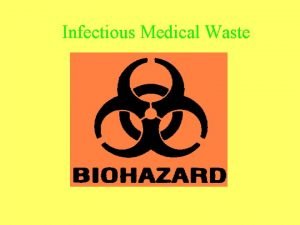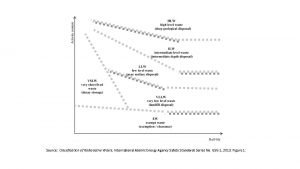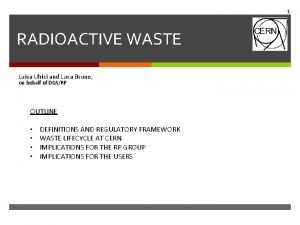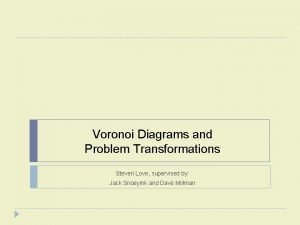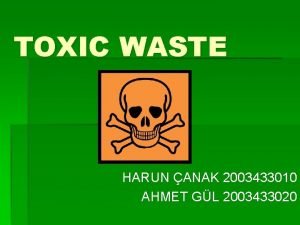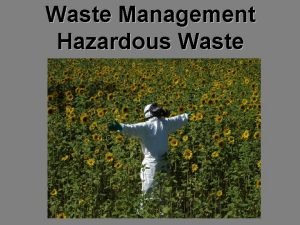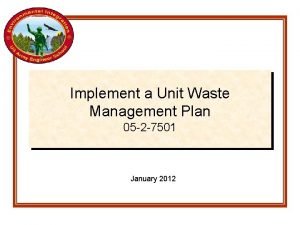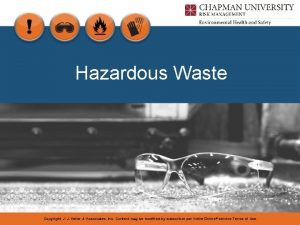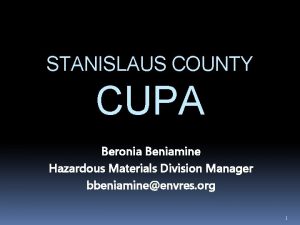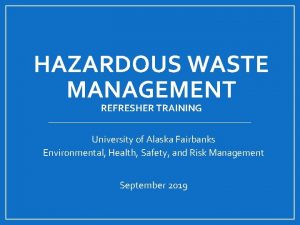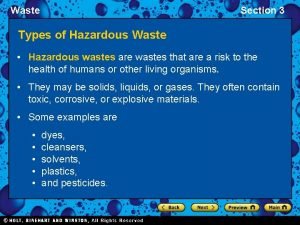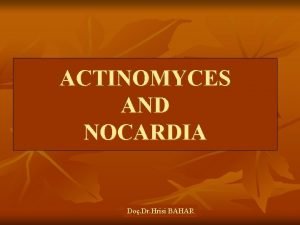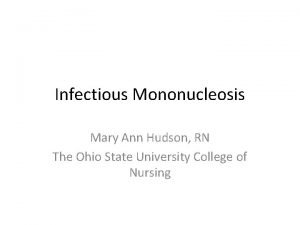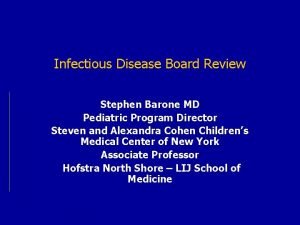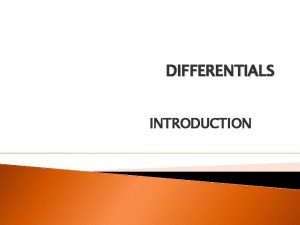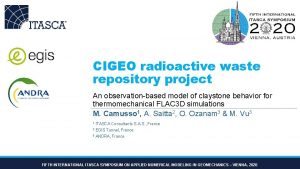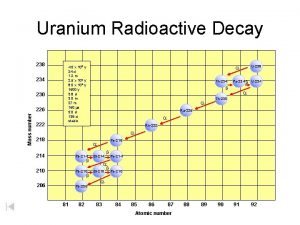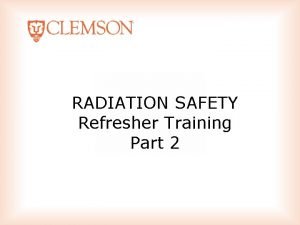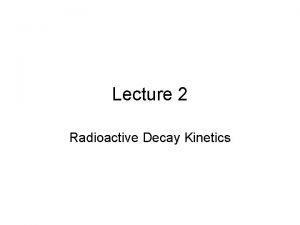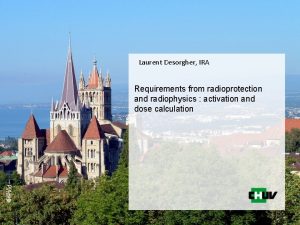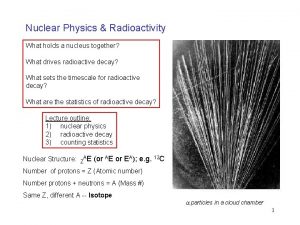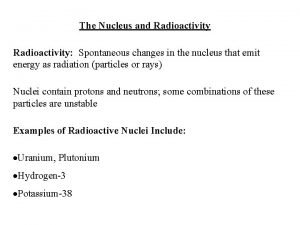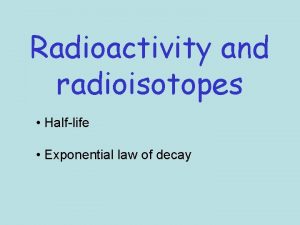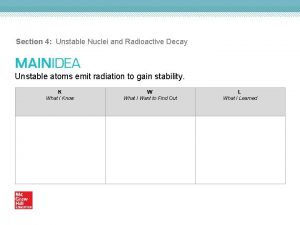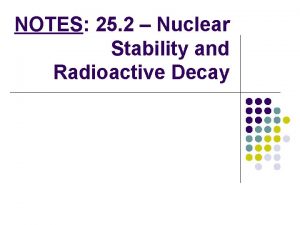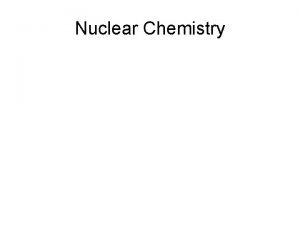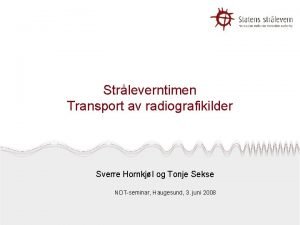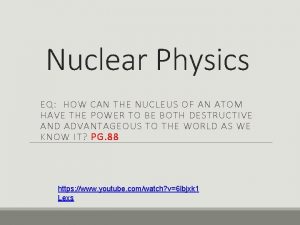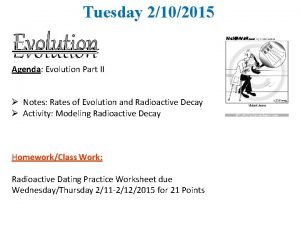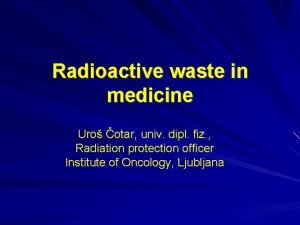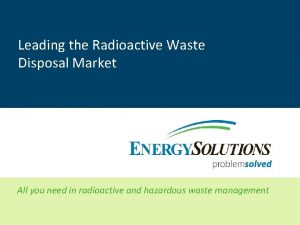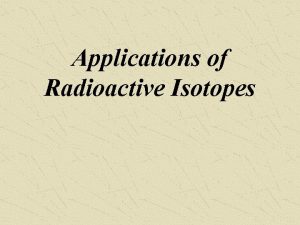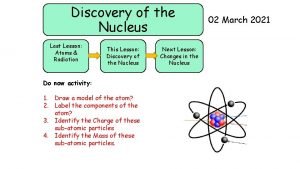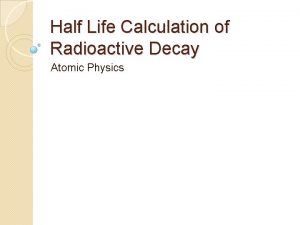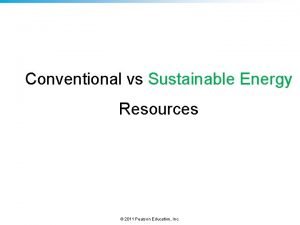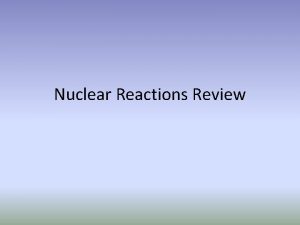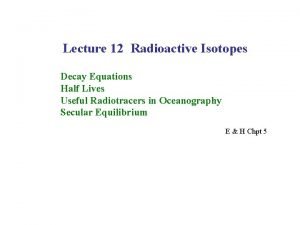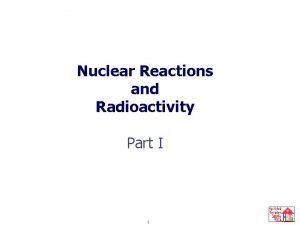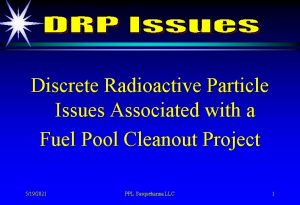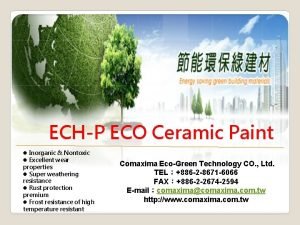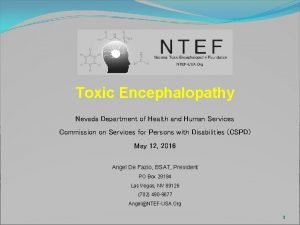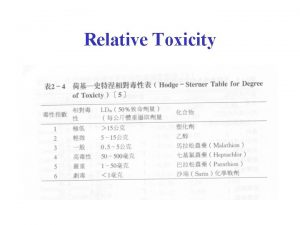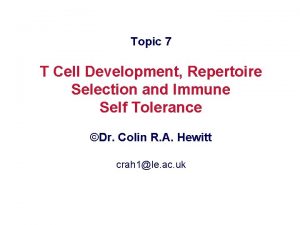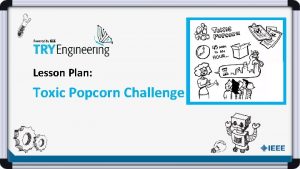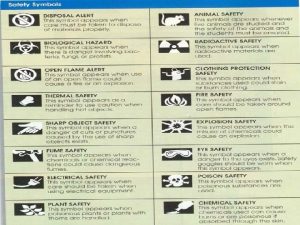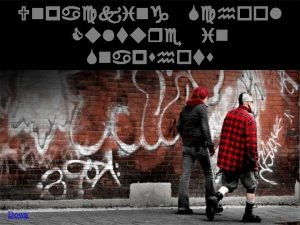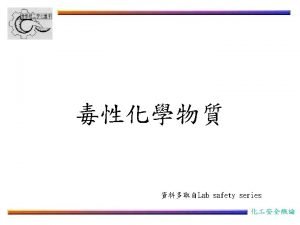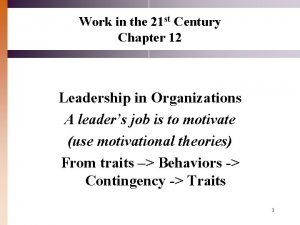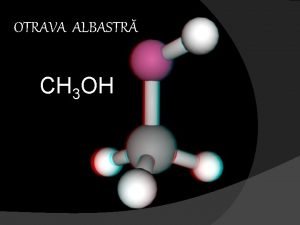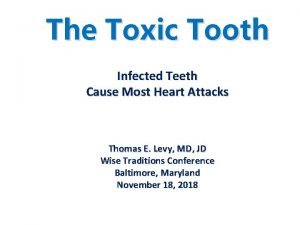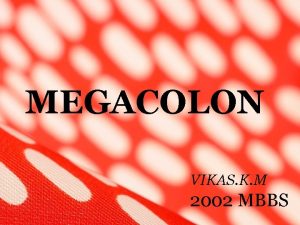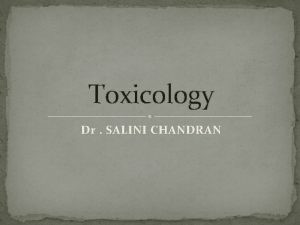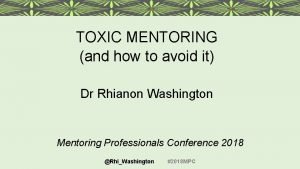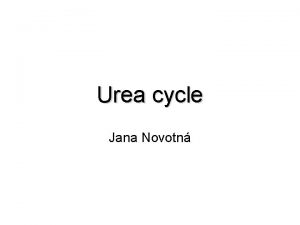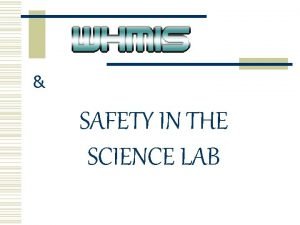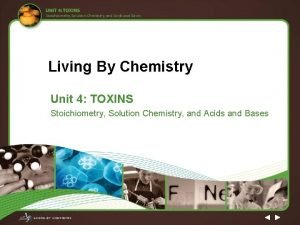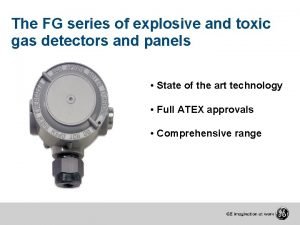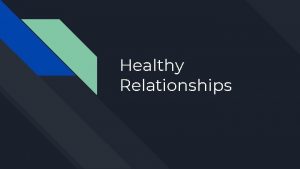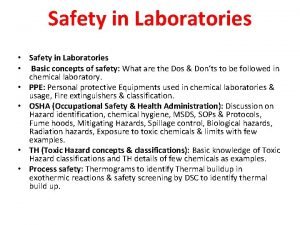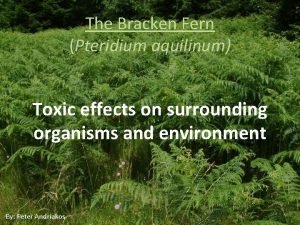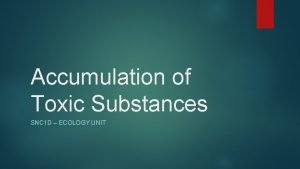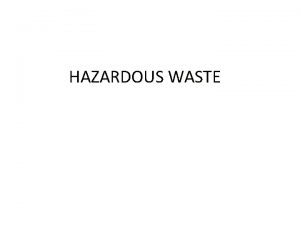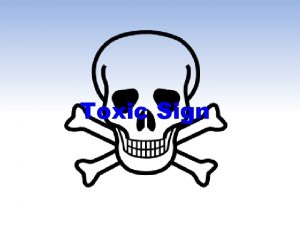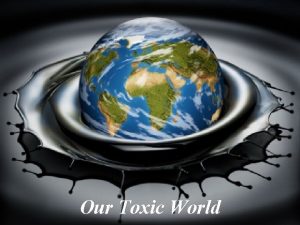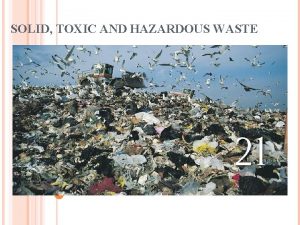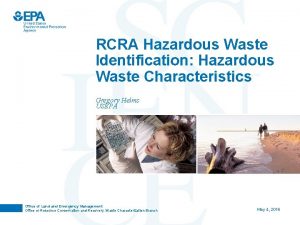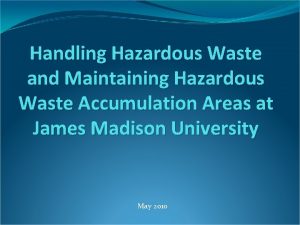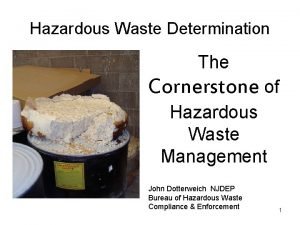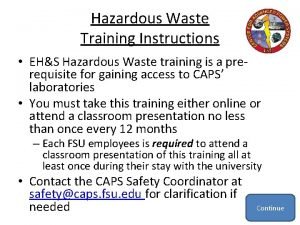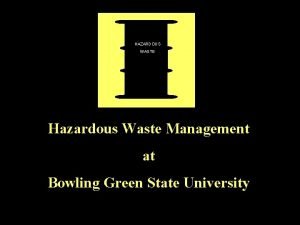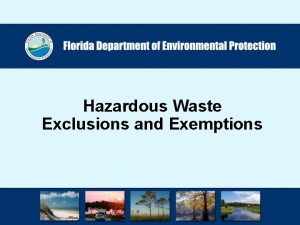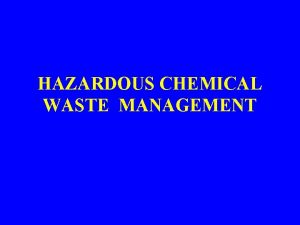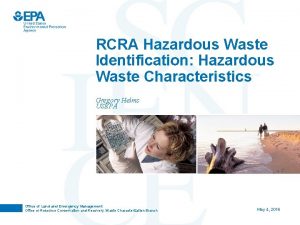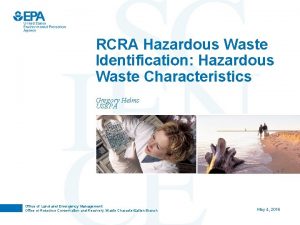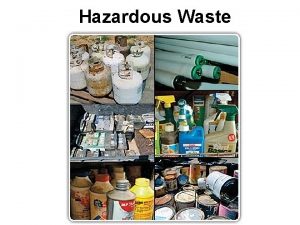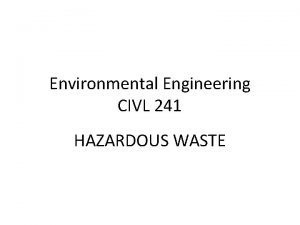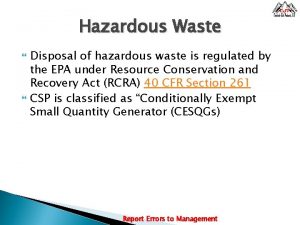HAZARDOUS WASTE Infectious Toxic Radioactive Hazardous Waste Lecture



































































































- Slides: 99

HAZARDOUS WASTE (Infectious, Toxic, Radioactive)

Hazardous Waste Lecture Outline n n n n Legislation/RCRA/CERCLA National Priority List Definition/ Categories Toxicity/Exposure/Health Effects The Love Canal Tragedy Household Hazardous chemicals/cleaners/swimming pool/auto related Methods of disposal Treatment and Monitoring

Toxic Chemicals In The Environment There are more than 116, 000 registered, with EPA, chemicals in daily use n And about 22 chemicals/week x 52 weeks /year = 1144 chemicals /year manufactured each year. n Organic chemical substances, including pesticide, make up a large portion of these compounds. n

Risk Assessment and Risk Management/Communication Risk Assessment Risk Management Dose-Response Curves Hazard Identification Risk Characterization Public Health Affects -Social and Economic Factors -Legislation and Politics Exposure Assessment Risk Communication Plan Environmental Health and Ecological Effects Monitoring and Proper waste disposal, Public Protection/USEPA

Who is Responsible for hazardous Waste Department of Transportation (DOT) F DOT F EPA Regulates Interstate Transportation Sets standards for manifest, shipping tickets F Coast Guard Shipments of Oil on water bodies

Haz. Waste n RCRA is a Resource Conservation and Recovery Act which was approved by the congress in 1976. n The Act is designed to reduce the hazards of this waste by tracking it from the point of generation to the final disposal. RCRA defines hazardous waste, sets rules for handling treatment and disposal. n

1984 Amendment to RCRA 1. Reduction of the amount buried in landfills n 2. Improve design and operations of landfills n 3. Small generators : 100 kg(220 lbs) per month or more are subjected to regulations used to be for 1000 kg or more. n

RCRA amendment(cont. ) n 4. Create a new program for detecting and monitoring leakage from underground storage tanks such as gas stations

Abandoned HW Dumpsites n EPA estimates that the owners of about 50, 000 abandoned hazardous waste dumpsites are unknown. (leakage and leachate. n The public demanded that something has to be done about cleaning these sites

CERCLA: The “Superfund” Act n Therefore, in 1980 the congress enacted the “Comprehensive Environmental Response, Compensation and Liability Act” CERCLA known as the Superfund Act to stop polluting and making owners liable and responsible for the clean up of their discharges.

CERCLA Amendment n Superfund Amendments and Reauthorization Act of 1986 (SARA) n SARA also required EPA to revise the Hazard Ranking System (HRS) to ensure that it accurately assessed the relative degree of risk to human health and the environment posed by uncontrolled hazardous waste sites that may be placed on the National Priority List (NPL).

What Is A Hazardous Chemical Waste n RCRA defines hazardous waste as any discarded material that may pose a substantial threat or potential danger to human health or the environment when improperly handled.

What Is A Hazardous Chemical Waste n Federal and State regulations define hazardous waste as a substance that poses a hazard to human health or the environment when improperly managed.

Haz. Waste n Improper management of hazardous waste can pose a Risk to human health and the Environment in many ways: n Direct contact: skin, inhalation, ingestion acute or chronic exposure Explosions and fire hazards: Food contamination: food chain Air Pollution , Soil Contamination Surface and ground water contamination n n

Environmental Factors and Birth Defects n n n n Exposure to hazardous waste could result in Birth Defects leading to infant mortality. Glycol Ethers Glycol ethers may be used alone or in combination with other ingredients in paints, varnishes, dyes, stains, and inks semiconductor chip coatings degreasers and dry-cleaning fluids brake fluids and jet fuel de-icing additives

Associated Birth Defects with Certain Toxic Chemicals. Hair dye n Benzene n Lead n Toluene n Triazine n PCB’s n Agricultural work n cardiac Neural tube defect CNS Microcephaly low weight CNS oral clefts

What Is A Hazardous Chemical Waste n A chemical waste is considered hazardous if it is either listed on one of the lists of hazardous wastes found in the Federal or State regulations, or exhibits one or more of the four characteristics listed below:

Haz. Waste Characteristics Any waste which exhibits one or more of the following characteristics. * Ignitable * Corrosive * Reactive * Toxic n

Characteristics: n I Ignitable n Flashpoint <140 degrees F Capable of causing fire at standard temperature and pressure through friction, absorption of moisture, or spontaneous chemical changes Is an ignitable compressed gas / Examples : Methane/Butane gases n n n

Characteristics: II- Corrosive n Liquid with p. H less than or equal to 2 or greater than or equal to 12. 5 n Solid that has p. H less than or equal to 2 or greater than or equal to 12. 5 when mixed with equal weight of water n Examples : Hydrochloric acid, Sulfuric acid and Lime n

Characteristics: n III- Reactive n Reacts violently with water Forms potentially explosive mixtures with water Forms toxic gases, vapors, or fumes when mixed with water Is a cyanide or sulfide bearing waste which, when exposed to p. H conditions between 2 and 12. 5, can generate toxic gases, vapors, or fumes n n n

Characteristics: IV- Toxic Has an acute aquatic 96 -hour LC 50 less than 500 mg/l Has an acute oral LD 50 less than 2, 500 mg/kg Has an acute dermal LD 50 less than 4, 300 mg/kg Has an acute inhalation LC 50 less than 10, 000 ppm as a gas or vapor TCLP : Toxicity Characteristic Leaching Procedure Examples : Arsenic, Mercury, Lead

National Priority List(NPL) n More than $20 Billion had been allocated for clean-up activities. The EPA and local state agencies developed a NPL of about 1300 sites require immediate clean-up. They contain Lead, Arsenic, Mercury, Benzene, Vinyl Chloride, Cadmium, PCB’s. etc.

The following table shows the number NPL of Federal and General sites for each status and milestone as of OCTOBER 25, 2011: n Status n Proposed sites 57 Final sites 1140 Deleted Sites 339 Partial Deletion 40 n n n Non Federal Total 5 158 15 17 62 1298 394 57

Clean-up n After spending $25 Billion, only 80 sites had been “delisted “ and cleaning is in progress at 360 sites.

Examples of Hazardous Chemicals Aldrin, Dieldrin, Parathion Arsenic, Lead oxides Aluminum phosphide Calcium cyanide Benzene

The Love Canal Tragedy

The Love Canal Tragedy

The Love Canal Tragedy


The Love Canal Tragedy

The Love Canal William T. Love came to 1890 s Niagara Falls, New York, with hugely ambitious plans. n The landowner envisioned the creation of a city would be home to industry, and housing for more than a million people. n

The Love Canal Tragedy Thousands of acres would become “the most extensive and beautiful [park] in the world”. n Within a year, however, Love’s plans failed, and would quickly have been forgotten if it weren’t for one problem. n

The love canal Tragedy n In 1920 the city of Niagara Falls, a growing industrial town, purchased a kilometer-long pit that immediately started using the pit as a dumping ground for chemical wastes.

The love canal Tragedy n This continued for more than twenty years, after which a Chemical and Plastics Corporation purchased the land for their own chemical disposal. n By 1953, the company had buried nearly 22, 000 tons of waste, and the pit was virtually full.

The love canal Tragedy n At that time, the dangers of chemical wastes were almost entirely unknown. n The city’s residents were delighted at the medical and other developments that the chemical industry was bringing in. n The Love Canal was lined with clay and covered with dirt to supposedly seal it, and company’s Chemical experts declared it safe. n

The Love Canal Tragedy n It is not certain whether the company suspected the potential effects of its waste products. n However, the fact that the company sold the Love Canal land for a single dollar is suspicious. n So is the carefully-worded disclaimer that company included with the sale, disclaiming any responsibility for side-effects from chemical exposure

The Love Canal Tragedy n . n The Niagara Falls Board of Education, which was in urgent need of more classroom space, began constructing a new elementary school. n In 1955, four hundred children began attending the school, as about 100 homes were built in the surrounding areas. n Although most of the residents of Niagara Falls knew what the land had been previously used for, they were not cautioned about living on it.

The Love Canal Tragedy Unsurprisingly, the direct effects of the pit’s contents were soon felt. n Strange odors and substances were reported by residents, especially those with basements. n Pieces of phosphorus made their way to the surface; children in the schoolyard were burned by toxic waste. n Local officials were alerted, but took no action. n

The Love Canal Tragedy n In 1976, water from heavy rains and a record-breaking blizzard caused a significant amount of chemical waste to migrate to the surface, where it contaminated the entire neighborhood.

The Love Canal Tragedy n In the following years the area was stricken with higher than normal rates of stillborn births and miscarriages, and many babies were born with birth defects. n .

The Love Canal Tragedy n Informal studies by the Agency for Toxic Substances and Disease Registry, observed more than 400 types of chemicals in the air, water, and soil, with some of them – such as benzene – already known to be carcinogenic

The Love Canal Tragedy Finally, in the spring of 1978, state health commissioner declared the area around the Love Canal hazardous. n The school closed, the land was sectioned off, and more than 200 families in the immediate area were evacuated. n

The Love Canal Tragedy n By August of that year, President Jimmy Carter called upon the Federal Disaster Assistance Agency for its help

Love Canal Tragedy Evacuation from the Love Canal neighborhood n. Lawsuits were quick to arrive, and the Company found itself being sued for more than $11 billion. n n

The Love Canal Tragedy The Company denied its involvement through this series, even when faced by the Federal Justice Department in 1979 and New York State in 1989. n Still, a great deal of damage had been done, and eventually more than 1, 000 families had to be moved out of the Love Canal area. n

Love Canal Tragedy n Fifteen Love Canal babies born between January 1979 and January 1980, only two were healthy. n Agencies at the state and federal levels spent hundreds of millions of dollars trying to clean up the pollution. Of that, Chemical Company has eventually been persuaded to contribute about $130 million.

Love Canal Tragedy One good thing that came out of the disaster was the creation of n CERCLA n Comprehensive Environmental Response, Compensation, and Liability Act, more commonly known as the ‘Superfund’ law n

Love Canal Tragedy n In the early 1990 s parts of the area were declared safe again, and now make up a neighborhood known as Black Creek Village. n The area was taken off the Superfund list in September 2004 at the announcement that certain clean-up goals had been reached. n

Love Canal Tragedy n Much of the Canal itself, however, remains sectioned off by a chain-link fence, which to any local passersby must serve as a reminder of the whole catastrophe.

n Agriculture Street landfill/New Orleans, Louisiana Superfund Site

Agriculture Street Landfill The 95 acres began to be used as an open dump for both residential and industrial in 1909. n It often caught fire with smoke and flames visible for a good distance away. n In 1966, it was covered by ash and compacted. n

Agriculture Street landfill/New Orleans, Louisiana Again, in 1976 , it was covered with soil and sand developed as residential neighborhood , small businesses and Moton Elementary School. n In 1986, complaints of health problems by residents, EPA investigation indicated that it was not worthy of Federal remedy. n

Agriculture Street landfill/New Orleans, Louisiana Residents continued to complain about high rate of cancer. n They found trash when digging for fence construction and planting a garden. n

Agriculture Street landfill/New Orleans, Louisiana In 1993, residents petitioned the EPA for retesting and the site was listed as a superfund site, on the NPL. n Soil testing showed chemical contaminants as Arsenic, Lead and Polychlorinated aromatic hydrocarbons. n

Agriculture Street landfill/New Orleans, Louisiana n Remediation: Morton Elementary was closed n Two feet of soil were removed n A plastic sheeting was put down as a barrier n Then topping with two feet of clean new soil. n n

Agriculture Street landfill/New Orleans, Louisiana In 2001 , the site was declared 99% complete. n Many homeowners petitioned to be moved, but there was no funding provided. n Hurricane Katrina flooded the site and concerns are some of the toxic chemicals were released to the surface. n

Household hazardous Waste We have many hazardous material in daily use around the house. About 20 pounds per household per year n These include: n Paint and paint removers and thinners n auto related waste: antifreeze, oils, batteries n yard, laundry and pool chemicals n oven and window cleaners n

Batteries Lead acid batteries contain sulfuric acid. They are recyclable. n Household batteries: contain mercury, cadmium or silver these normally end in the sanitary landfill. n

Disposal Methods for Household Hazardous Wastes n n n Automotive Products Waste Oil/Gasoline Drain used oil into a plastic leak-proof container with a tight-fitting lid. Take to a service station or oil change business that accepts it for recycling or to the Household Hazardous Waste Facility. Discard EMPTY oil bottles in the trash with the lid on. DO NOT DUMP USED OIL on ground, into street drains or down the sink. One gallon of used oil contaminates one million gallons of water.

Automotive Products n n Antifreeze Drain used antifreeze into a plastic leak-proof container with a tight-fitting lid and take to a participating service station or the Household Hazardous Waste Facility for recycling. n Discard empty antifreeze container in the trash. n Keep out of reach of children, pets, and other animals. Antifreeze is highly poisonous when ingested. . n

Paint and related Products n n Art Supplies, Hobby and Craft Chemicals Check into non-toxic alternatives for some of these products. Take to the Household Hazardous Waste Facility for collection. Use adequate ventilation and exercise caution with these products. Never put brushes in mouth.

Paint and related products n n In a closed jar, allow sludge to settle to bottom, then pour off and re-use the clear liquid on top. Soak up sludge with an absorbent such as kitty litter, allow to dry in a well-ventilated area away from children and pets, then discard in the trash. Take unused portion to Household Hazardous Waste Facility.

*BATTERIES (household/auto) *INCANDESCENT BULBS *FLUORESCENT S BULBS *PESTICIDES *TELEVISIONS *AEROSOLS *PAINT (Latex and oil based) *PAINT THINNER, VARNISH *GROUT *HOUSEHOLD CLEANERS *DRAINO, BLEACH *GARDEN CHEMICALS *MURIATIC ACID *OIL, GASOLINE *FLAMMABLE LIQUIDS *MERCURY DEVICES *ANTIFREEZE * POOL SHOCK

Household Haz. waste n n n n n *BATTERIES (household/auto), TELEVISIONS *AEROSOLS *DRAINO, BLEACH *PESTICIDES *GROUT *FLAMMABLE LIQUIDS *GARDEN CHEMICALS *MERCURY DEVICES *MURIATIC ACID *ANTIFREEZE

Household Haz. Waste *Cell Phones/Beepers/Pagers n *Uninterruptible Power Supplies n *Security Systems n *Computers, processors, monitors n *Circuit Boards n *GPS devices n *MP 3 players n *DVD Movies & Video games n

Warning : Not accepting: explosives, radioactive materials, medical waste, asbestos, glass, hazardous waste from businesses or schools n n *These items should never be placed in garbage or curbside recycling carts or bins n n

n Sponsored by: Keep New Orleans Beautiful, CACRC, The Green Project, FCC Environmental, Sewerage and Water Board, Materials Management Group, The Young Leadership Council, Urban League Young Professionals, Coca Cola, Office of Neighborhood Engagement, Office of Coastal and Environmental Affairs, DPM, DPW, NOPD, NOFD, NOEMS, OPSO.

House Hold Hazardous Waste Collection Day /Slidell/St Tammany Parish/ Louisiana n Residents can dispose of environmentally unsafe materials such as. n latex, oil-based and polyurethane paints in original containers with readable labels; n mineral spirits, kerosene, lamp oil and turpentine in original containers with readable labels; n all types of batteries;

St. Tammany Parish/ Household Hazardous Waste (conti) n cell phones; n fluorescent and incandescent lights; n mercury-containing devices such as thermometers and thermostats. n computers, monitors, printer and ink jet cartridges, fax machines, televisions, microwave ovens, n stereo and radio equipment, typewriters and VCR-DVD players also will be collected. n Residents can drop off up to five automobile or light-truck tires per household at the event.

Pesticides Herbicides, insecticides and rodenticides n Rinse containers with water and use the water for diluting the pesticide n If you cannot use it, give it to someone who can. n Banned pesticides must not be used n

Swimming Pool Chemicals and Wood Preservatives Chlorine compounds: corrosive and irritants. n Wood Preservatives: Pentachlorophenols or creosote, these include organic solvents as well as pesticides to control insects. fungi. n Treated wood should never be used as firewood; toxic fumes n

What we should know about medical waste. n n n Federal Regulations, OSHA. Packaging, labeling, storage, transportation, and treatment. Definition, sharps, body fluids, human an animal organs, etc. Louisiana Regulation General and specific risks to patients and staff General and specific risks to landfill operators

Hazardous Waste Disposal



Methods of Treatment and Disposal of Hazardous Waste A. Physical Treatment n Carbon adsorption n Evaporation n Filtration n Sedimentation n Membrane processes n

Chemical Treatment Neutralization n Oxidation n Reduction n Precipitation n

Thermal Plasma process: It does not require extensive characteristics or pretreatment. n Temperature sufficient to volatilize hazardous waste (3000 F, 1648 C) n Conventional Incineration (1600 -2200 F )(871 -1204 C) n

Biological 1 - Activated sludge n 2 - Trickling filters n 3 - Land application n

Disposal / Storage 1 - Deep-well injection n 2 - Land burial/landfills n 3 - Engineering storage n

Injection Wells

Injection wells 1. Hazardous Waste Disposal Wells. These wells inject hazardous waste, as defined by the Resource Conservation and Recovery Act ( RCRA). Hazardous waste disposal wells are stringently regulated by the Safe Drinking Water Act and RCRA.

Injection Wells 1. 2. Most Class I hazardous wells are located at industrial facilities. Only a few Class I wells are at commercial operations that can accept hazardous waste generated offsite. Class I hazardous waste wells operate in 10 states with the majority in Texas and Louisiana. Approximately 22 percent of Class I wells are hazardous waste disposal wells.

Transformers


Fracking Hazardous waste May 09, 2012/ Natural Resources Defense Council 2012 n The process used to extract natural gas from underground shale formations, called hydraulic fracturing or “fracking, ” creates potentially hazardous wastewater byproducts. These byproducts include the fracking fluid that returns to the surface of the natural gas well, along with water that’s released from inside the shale formation.

n This wastewater contains salts, oil and grease, metals, radioactive material, and manmade fracking chemicals. These pollutants can be dangerous if they’re released into the environment without

(Photo credit: Albany Times Union).

Current Methods of Treatment: n n n 1) Treatment & discharge into surface waters – Usually is treated at a privately owned industrial wastewater treatment facility which removes pollutants. OR Sent to municipal sewage treatment plants, which aren’t designed to handle such waste. Actually just dilute the pollutants rather than removing them. Both methods discharge the treated waste into surface waters.

2 - Spreading onto roads for ice or dust control – n Since it’s so salty, some of this waste is used as deicing or dust control agent. n

3 - Disposal or storage in open pits - Some wastewater is stored in open pits. n Risk of water , soil and air n


n 4 - Underground injection - Fracking wastewater is often injected underground into disposal wells which might lead to a risk of groundwater contamination and earthquakes. .

Recycling Of Hazardous Waste n Transformers n PCB and non-PCB contaminated oil is removed from all electrical equipment. Contaminated metals are cleaned and recycled reducing your liability. PCB wastes are incinerated or sent to a secure TSCA authorized landfill. Mineral oil containing less than 50 ppm PCBs is cleaned and recycled as a lubricant. n n n

Monitoring And measurement A) n B) n C) n Sampling Analysis Toxicity testing

Human Exposure: A. Food chain B. Application(preparation and spraying) C. Manufacturing D. Farming ( planting, harvesting)

Risk Assessment and Risk Management/Communication Risk Assessment Risk Management Dose-Response Curves Hazard Identification Risk Characterization Public Health Affects -Social and Economic Factors -Legislation and Politics Exposure Assessment Risk Communication Plan Environmental Health and Ecological Effects Monitoring and Proper waste disposal, Public Protection/USEPA

Injection Wells n What is a Class I well? Class I wells inject hazardous and non-hazardous wastes into deep, isolated rock formations that are thousands of feet below the lowermost USDW. n n n n n Class I Injection Wells - Isolate hazardous, industrial and municipal wastes through deep injection. Class I wells are used mainly by the following industries: Petroleum Refining Metal Production Chemical Production Pharmaceutical Production Commercial Disposal Food Production Municipal Wastewater Treatment
 Mebosha
Mebosha Radiation pollution conclusion
Radiation pollution conclusion Radioactive nuclear waste
Radioactive nuclear waste Radioactive waste
Radioactive waste Toxic waste dump problem voronoi
Toxic waste dump problem voronoi Toxic waste causes
Toxic waste causes Sample of hazardous waste
Sample of hazardous waste Segregation of hazardous waste
Segregation of hazardous waste Hazardous waste neha
Hazardous waste neha Solid and hazardous waste
Solid and hazardous waste E-waste definition apes
E-waste definition apes Keller hazardous waste disposal
Keller hazardous waste disposal Stanislaus county hazardous waste
Stanislaus county hazardous waste Alaska hazmat training
Alaska hazmat training Section 3 hazardous waste answers
Section 3 hazardous waste answers 01:640:244 lecture notes - lecture 15: plat, idah, farad
01:640:244 lecture notes - lecture 15: plat, idah, farad Infectious stunting syndrome
Infectious stunting syndrome Smallest infectious agents
Smallest infectious agents Infectious disease quality controls
Infectious disease quality controls Emerging infectious diseases
Emerging infectious diseases Infectious disease
Infectious disease Infectious canine hepatitis in dogs
Infectious canine hepatitis in dogs Papillomitosis
Papillomitosis Periods of infectious disease
Periods of infectious disease Hpps symbols
Hpps symbols Infectious mononucleosis
Infectious mononucleosis Stridor
Stridor Infectious nucleic acid
Infectious nucleic acid Chapter 26 infectious disease prevention and control
Chapter 26 infectious disease prevention and control Noncellular infectious protein particles are called
Noncellular infectious protein particles are called Hennepin county infectious disease manual
Hennepin county infectious disease manual Icd 10 morbus hansen
Icd 10 morbus hansen University of washington
University of washington Stages of infectious disease
Stages of infectious disease Radioactive decay law
Radioactive decay law Radioactive flac
Radioactive flac Is lead radioactive
Is lead radioactive Refresher training example
Refresher training example Beta minus decay
Beta minus decay Isotope decay formula
Isotope decay formula Radioactive decay formula
Radioactive decay formula Radioactive decay law
Radioactive decay law Cobalt-60 nuclear decay equation
Cobalt-60 nuclear decay equation Radioactive tracers in agriculture
Radioactive tracers in agriculture Law of exponential decay
Law of exponential decay How unstable atoms gain stability
How unstable atoms gain stability Half life example
Half life example Chapter 24: nuclear chemistry answer key
Chapter 24: nuclear chemistry answer key Type of radioactive decay
Type of radioactive decay Type of radioactive decay
Type of radioactive decay Un3332 radioactive material
Un3332 radioactive material Beta minus decay
Beta minus decay Radioactive dating worksheet
Radioactive dating worksheet Most unstable radioactive element
Most unstable radioactive element Rolf sievert
Rolf sievert Energy solutions barnwell sc
Energy solutions barnwell sc Uses of radioactive isotopes
Uses of radioactive isotopes Discovery of nucleus of atom
Discovery of nucleus of atom Half life calculation
Half life calculation Radioactive fallout from chernobyl
Radioactive fallout from chernobyl Radioactive defination
Radioactive defination Radioactive materials have unstable
Radioactive materials have unstable Radioactive decay formula
Radioactive decay formula Gamma decay nuclear equation
Gamma decay nuclear equation Discrete radioactive particles
Discrete radioactive particles Non toxic ceramic paint
Non toxic ceramic paint Multinodular goiter pathophysiology
Multinodular goiter pathophysiology Acute toxic encephalopathy icd 10
Acute toxic encephalopathy icd 10 Which is more toxic
Which is more toxic Double positive t cells
Double positive t cells Toxic popcorn challenge solution
Toxic popcorn challenge solution Mixoedema
Mixoedema Poly relationships
Poly relationships Identifying toxic people
Identifying toxic people Toxic
Toxic The history of grading practices
The history of grading practices Schoolofeducators
Schoolofeducators Relationship scenarios for adults
Relationship scenarios for adults Be toxic
Be toxic Toxic triangle of destructive leadership
Toxic triangle of destructive leadership Metanolul este foarte inflamabil si arde cu o flacara
Metanolul este foarte inflamabil si arde cu o flacara The toxic tooth
The toxic tooth Shepard fairey
Shepard fairey Toxic megacolon treatment
Toxic megacolon treatment Which is more toxic
Which is more toxic Toxic friendships
Toxic friendships Cerbera thevetia active principle
Cerbera thevetia active principle Toxic triangle of destructive leadership
Toxic triangle of destructive leadership Toxic mentors
Toxic mentors Amino acid to urea
Amino acid to urea Toxic symbol
Toxic symbol Toxic reactions chemical equations
Toxic reactions chemical equations Fgc toxic
Fgc toxic Toxic relationship quiz pdf
Toxic relationship quiz pdf Toxic relatiinship
Toxic relatiinship Lesson 68 toxic reactions chemical equations
Lesson 68 toxic reactions chemical equations Toxic substances control
Toxic substances control How toxic is bracken fern
How toxic is bracken fern Toxic leadership styles
Toxic leadership styles Accumulation of toxic substances
Accumulation of toxic substances
